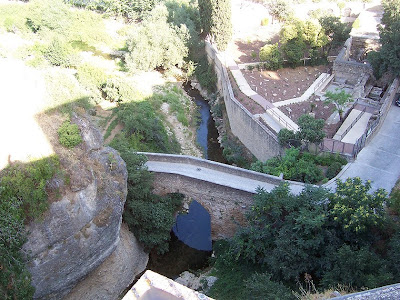When we arrived the image was even more off-putting of a modern Spanish city with a typical commercial centre full of shuttered buildings surrounded by a suburban sprawl with supermarkets and industrial estates, however, when you look at the map in detail you can see that the whole city somehow focuses on a ravine and a crevice of city that crosses it in a thin wedge.
Its a city that goes back to fortress defences in Moorish times and continues as a religious centre drawn to the precipice of the ravine that marks the only passage across to the sanctuary on the high bluffs beyond, giving the city a unique mysterious persona.
In fact its history goes away back to the Celts who called it Arunda and it was already a city in the time of the Romans. Here is an extract from Wikipedia.
Around the city are remains of prehistoric settlements dating to the Neolithic Age, including the rock paintingsCueva de la Pileta. Ronda was however first settled by the early Celts, who, in the 6th century BC, called it Arunda. Later Phoenician settlers established themselves nearby to found Acinipo, known locally as Ronda la Vieja, Arunda or Old Ronda. The current Ronda is however of Roman origins[1], having been founded as a fortified post in the Second Punic War, by Scipio Africanus. Ronda received the title of city at the time of Julius Caesar.
In the 5th century AD Ronda was conquered by the Suebi, led by Rechila, being reconquered in the following century by the Eastern Roman Empire, under whose rule Acinipo was abandoned. Later the Visigoth king Leovigild captured the city. Ronda was part of the Visigoth reign until 713, when it fell to the Arabs, who named it Izn-Rand Onda ("city of the castle") and made it the capital of the Takurunna province.
After the disintegration of the caliphate of Córdoba, Ronda became the capital of a small kingdom, the taifa of Ronda. During this period Ronda received most of its islamic architectural heritage. In 1065 Ronda was conquered by the taifa of Seville led by Abbad II al-Mu'tadid. Both the poet Salih ben Sharif al-RundiSufi scholar Ibn Abbad al-Rundi (1333-1390) were born in Ronda.
The islamic domination of Ronda ended in 1485, when it was conquered by the Marquis of Cádiz after a brief siege. Subsequently, mostly of the city's old edifices were renewed or adapted to Christian roles, while numerous others were built in newly-created quarters such as the Mercadillo and the San Francisco ones. The Real Maestranza de Caballería de Ronda was founded in the town in 1572, with military finalities.
In the early 19th century, the Napoleonic invasion and the subsequent Peninsular War caused much sufference in Ronda, whose inhabitants reduced from 15,600 to 5,000 in three years. Ronda's area became the base first of guerrila warriors, then of numerous bandits, whose deeds inspired artists such as Washington Irving, Prosper Mérimée and Gustave Doré. In the 19th century the economy of Ronda was mainly rural. In 1918 the city was the seat of the Assembly of Ronda, in which the Andalusian flag, coat of arms and anthem were designed.
Ronda was heavily affected by the Spanish Civil War, after which much of the population emigrated elsewhere.
 Streets leading down to the crevice
Streets leading down to the crevice

The lower passage crosses above the low bridge and the ascends in a steep winding cobble-stoned street with hair-pin bends which climbs up into the fortress bluffs that now house Christian sanctuaries, but were previously Moorish Muslim structures probably constituting a defensive fortress.


 The altar of the church above right across the courtyard from the previous one
The altar of the church above right across the courtyard from the previous one

Next morning having photographed the old town bluffs from a distance as we drove in, we entered through the gate in the castle wall and suddenly found ourselves launched onto the even more mind boggling precipice spanned by the so-called "New Bridge" a stunningly high stone bridge over the ravine crossing it higher up and further to the northern edge of the gap. This is the Ronda of those ephemeral picture I had seen while still in New Zealand and it is what completes Ronda for us as a gem of a city.
























No comments:
Post a Comment